Economics for Sustainable Business - Case Study: Google and Facebook
VerifiedAdded on 2023/01/18
|9
|1600
|36
Case Study
AI Summary
This case study examines the economics of sustainable business, focusing on the relationship between digital and traditional media, and the market structures of Google and Facebook. It explores the dominance of these platforms in the Australian market, analyzing their market share, entry barriers, and strategic interdependence. The assignment further investigates the role of the Australian Competition and Consumer Commission (ACCC) in regulating these firms, particularly concerning transparency and consumer privacy. A comparison of the cost structures between digital and traditional media is provided, highlighting the marginal costs and economies of scale within digital platforms. The assignment also explores the implications of market power and the impact on journalism. The analysis includes relevant figures and tables illustrating market shares and cost comparisons.
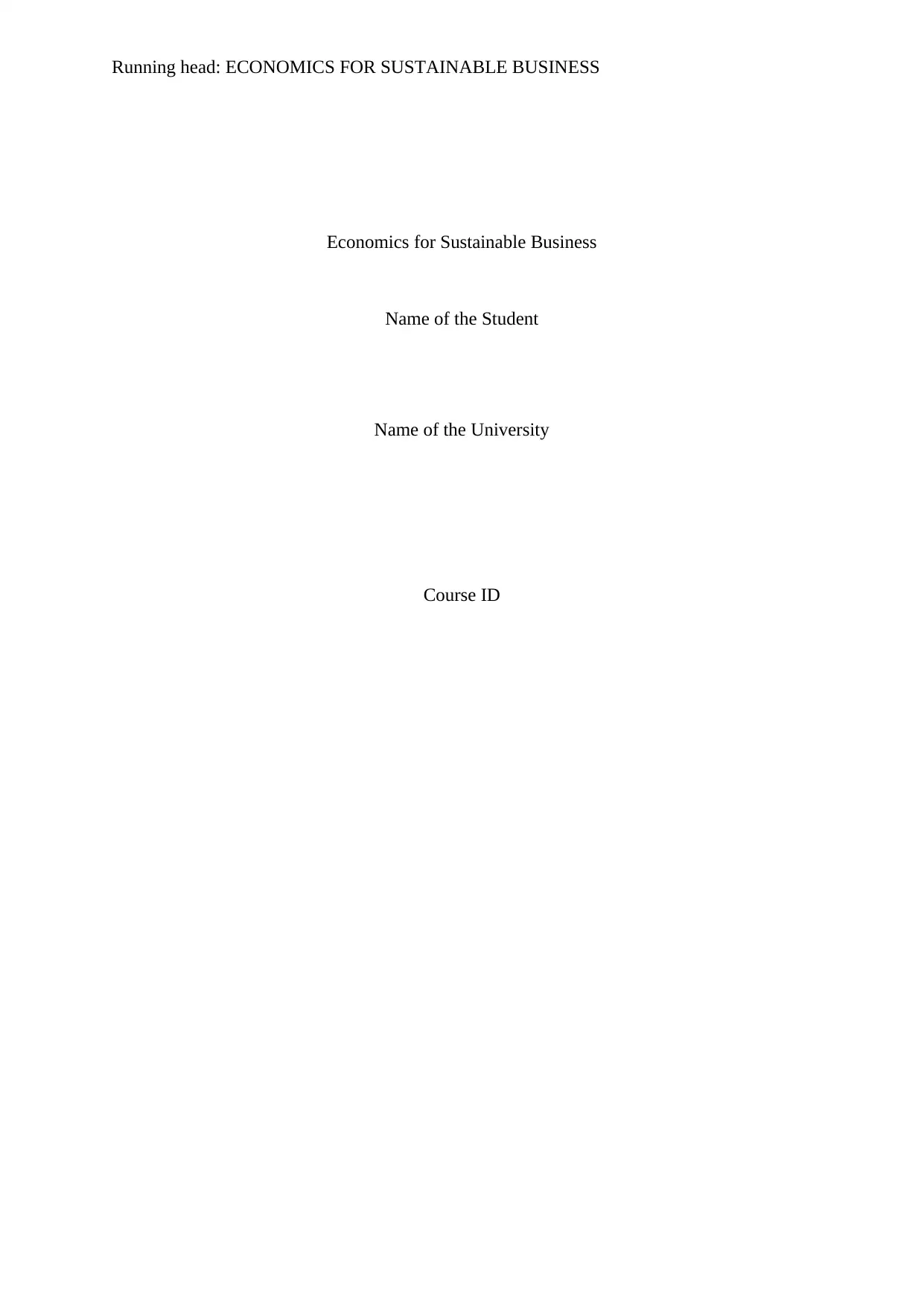
Running head: ECONOMICS FOR SUSTAINABLE BUSINESS
Economics for Sustainable Business
Name of the Student
Name of the University
Course ID
Economics for Sustainable Business
Name of the Student
Name of the University
Course ID
Paraphrase This Document
Need a fresh take? Get an instant paraphrase of this document with our AI Paraphraser
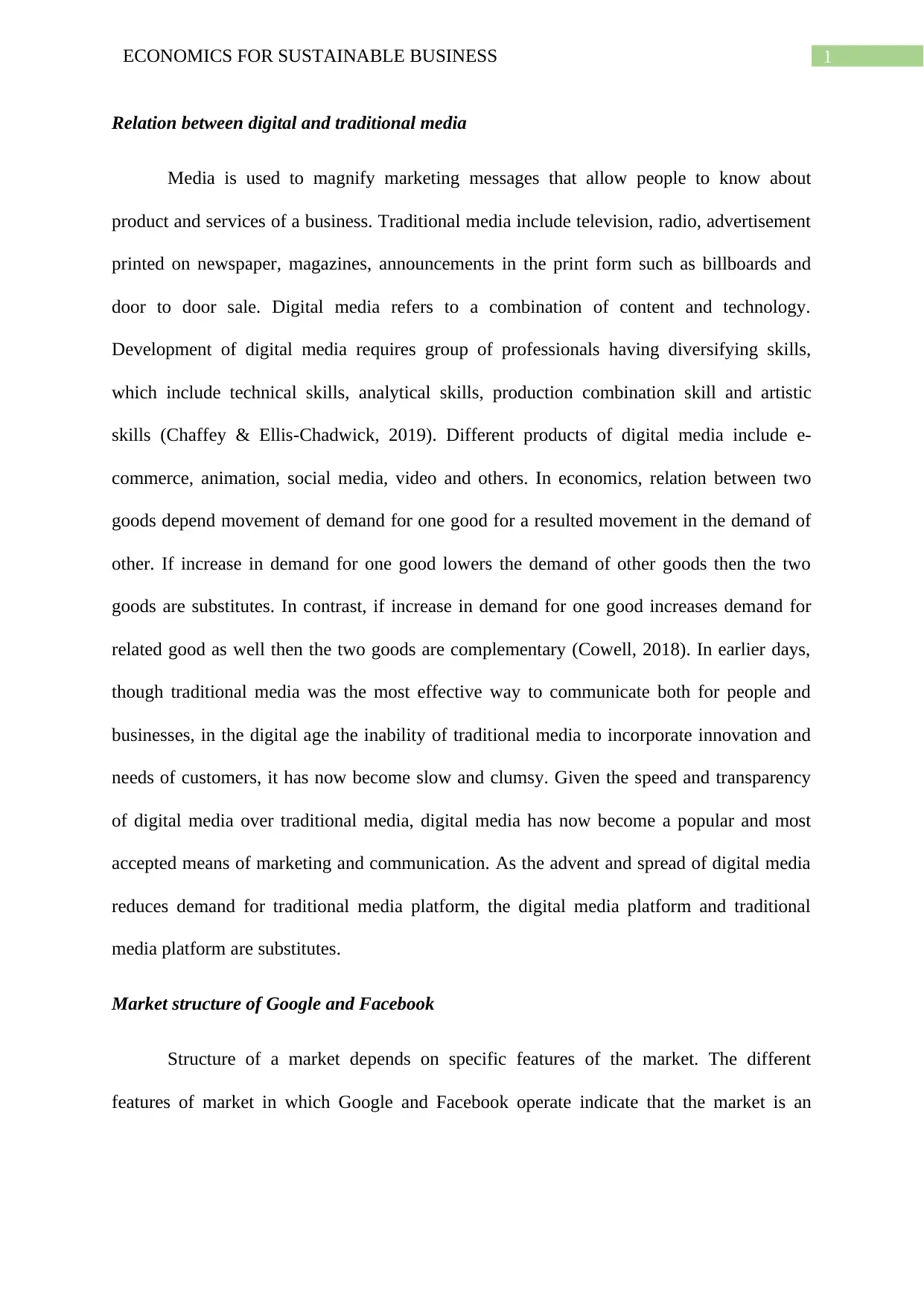
1ECONOMICS FOR SUSTAINABLE BUSINESS
Relation between digital and traditional media
Media is used to magnify marketing messages that allow people to know about
product and services of a business. Traditional media include television, radio, advertisement
printed on newspaper, magazines, announcements in the print form such as billboards and
door to door sale. Digital media refers to a combination of content and technology.
Development of digital media requires group of professionals having diversifying skills,
which include technical skills, analytical skills, production combination skill and artistic
skills (Chaffey & Ellis-Chadwick, 2019). Different products of digital media include e-
commerce, animation, social media, video and others. In economics, relation between two
goods depend movement of demand for one good for a resulted movement in the demand of
other. If increase in demand for one good lowers the demand of other goods then the two
goods are substitutes. In contrast, if increase in demand for one good increases demand for
related good as well then the two goods are complementary (Cowell, 2018). In earlier days,
though traditional media was the most effective way to communicate both for people and
businesses, in the digital age the inability of traditional media to incorporate innovation and
needs of customers, it has now become slow and clumsy. Given the speed and transparency
of digital media over traditional media, digital media has now become a popular and most
accepted means of marketing and communication. As the advent and spread of digital media
reduces demand for traditional media platform, the digital media platform and traditional
media platform are substitutes.
Market structure of Google and Facebook
Structure of a market depends on specific features of the market. The different
features of market in which Google and Facebook operate indicate that the market is an
Relation between digital and traditional media
Media is used to magnify marketing messages that allow people to know about
product and services of a business. Traditional media include television, radio, advertisement
printed on newspaper, magazines, announcements in the print form such as billboards and
door to door sale. Digital media refers to a combination of content and technology.
Development of digital media requires group of professionals having diversifying skills,
which include technical skills, analytical skills, production combination skill and artistic
skills (Chaffey & Ellis-Chadwick, 2019). Different products of digital media include e-
commerce, animation, social media, video and others. In economics, relation between two
goods depend movement of demand for one good for a resulted movement in the demand of
other. If increase in demand for one good lowers the demand of other goods then the two
goods are substitutes. In contrast, if increase in demand for one good increases demand for
related good as well then the two goods are complementary (Cowell, 2018). In earlier days,
though traditional media was the most effective way to communicate both for people and
businesses, in the digital age the inability of traditional media to incorporate innovation and
needs of customers, it has now become slow and clumsy. Given the speed and transparency
of digital media over traditional media, digital media has now become a popular and most
accepted means of marketing and communication. As the advent and spread of digital media
reduces demand for traditional media platform, the digital media platform and traditional
media platform are substitutes.
Market structure of Google and Facebook
Structure of a market depends on specific features of the market. The different
features of market in which Google and Facebook operate indicate that the market is an
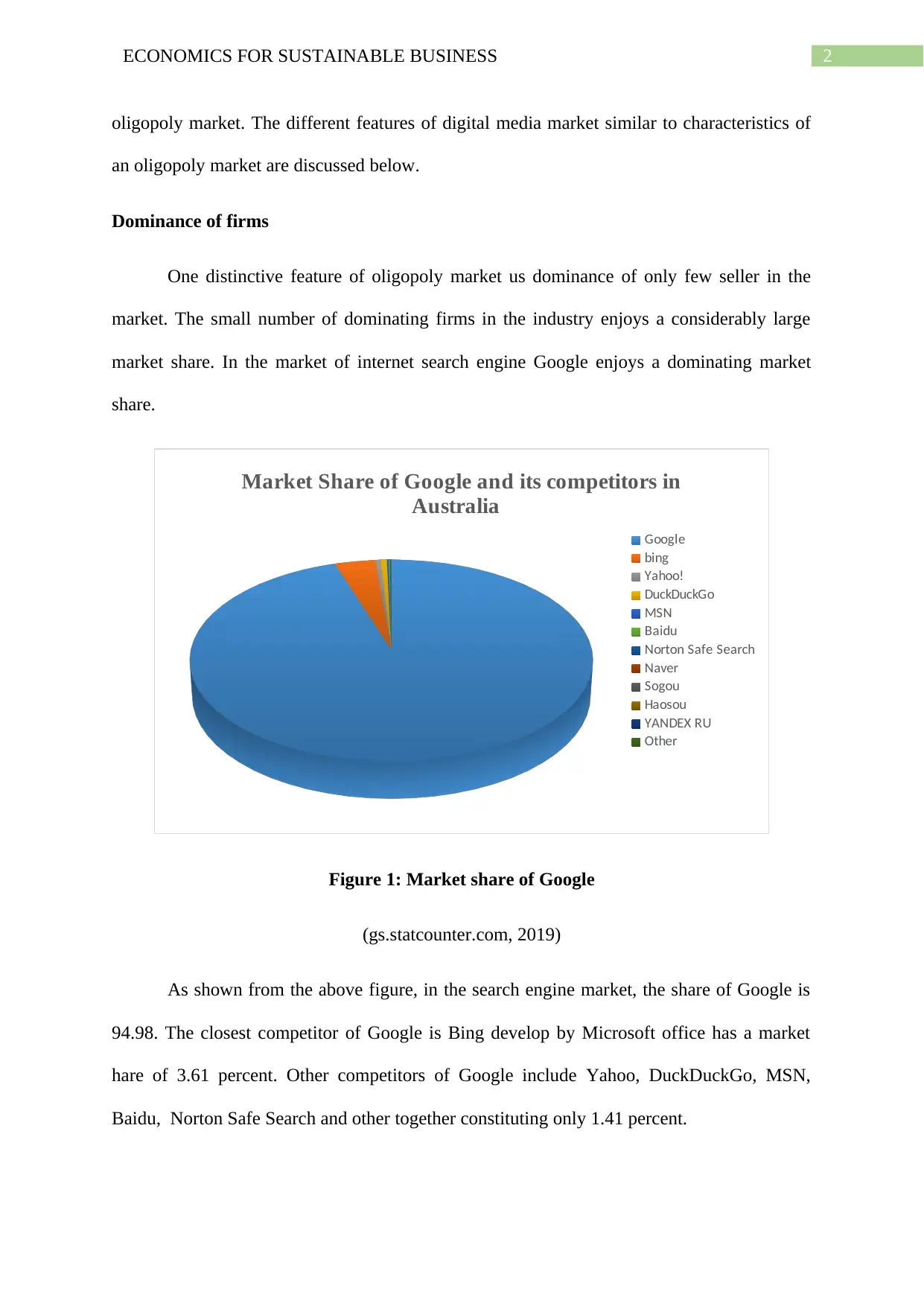
2ECONOMICS FOR SUSTAINABLE BUSINESS
oligopoly market. The different features of digital media market similar to characteristics of
an oligopoly market are discussed below.
Dominance of firms
One distinctive feature of oligopoly market us dominance of only few seller in the
market. The small number of dominating firms in the industry enjoys a considerably large
market share. In the market of internet search engine Google enjoys a dominating market
share.
Market Share of Google and its competitors in
Australia
Google
bing
Yahoo!
DuckDuckGo
MSN
Baidu
Norton Safe Search
Naver
Sogou
Haosou
YANDEX RU
Other
Figure 1: Market share of Google
(gs.statcounter.com, 2019)
As shown from the above figure, in the search engine market, the share of Google is
94.98. The closest competitor of Google is Bing develop by Microsoft office has a market
hare of 3.61 percent. Other competitors of Google include Yahoo, DuckDuckGo, MSN,
Baidu, Norton Safe Search and other together constituting only 1.41 percent.
oligopoly market. The different features of digital media market similar to characteristics of
an oligopoly market are discussed below.
Dominance of firms
One distinctive feature of oligopoly market us dominance of only few seller in the
market. The small number of dominating firms in the industry enjoys a considerably large
market share. In the market of internet search engine Google enjoys a dominating market
share.
Market Share of Google and its competitors in
Australia
bing
Yahoo!
DuckDuckGo
MSN
Baidu
Norton Safe Search
Naver
Sogou
Haosou
YANDEX RU
Other
Figure 1: Market share of Google
(gs.statcounter.com, 2019)
As shown from the above figure, in the search engine market, the share of Google is
94.98. The closest competitor of Google is Bing develop by Microsoft office has a market
hare of 3.61 percent. Other competitors of Google include Yahoo, DuckDuckGo, MSN,
Baidu, Norton Safe Search and other together constituting only 1.41 percent.
⊘ This is a preview!⊘
Do you want full access?
Subscribe today to unlock all pages.

Trusted by 1+ million students worldwide
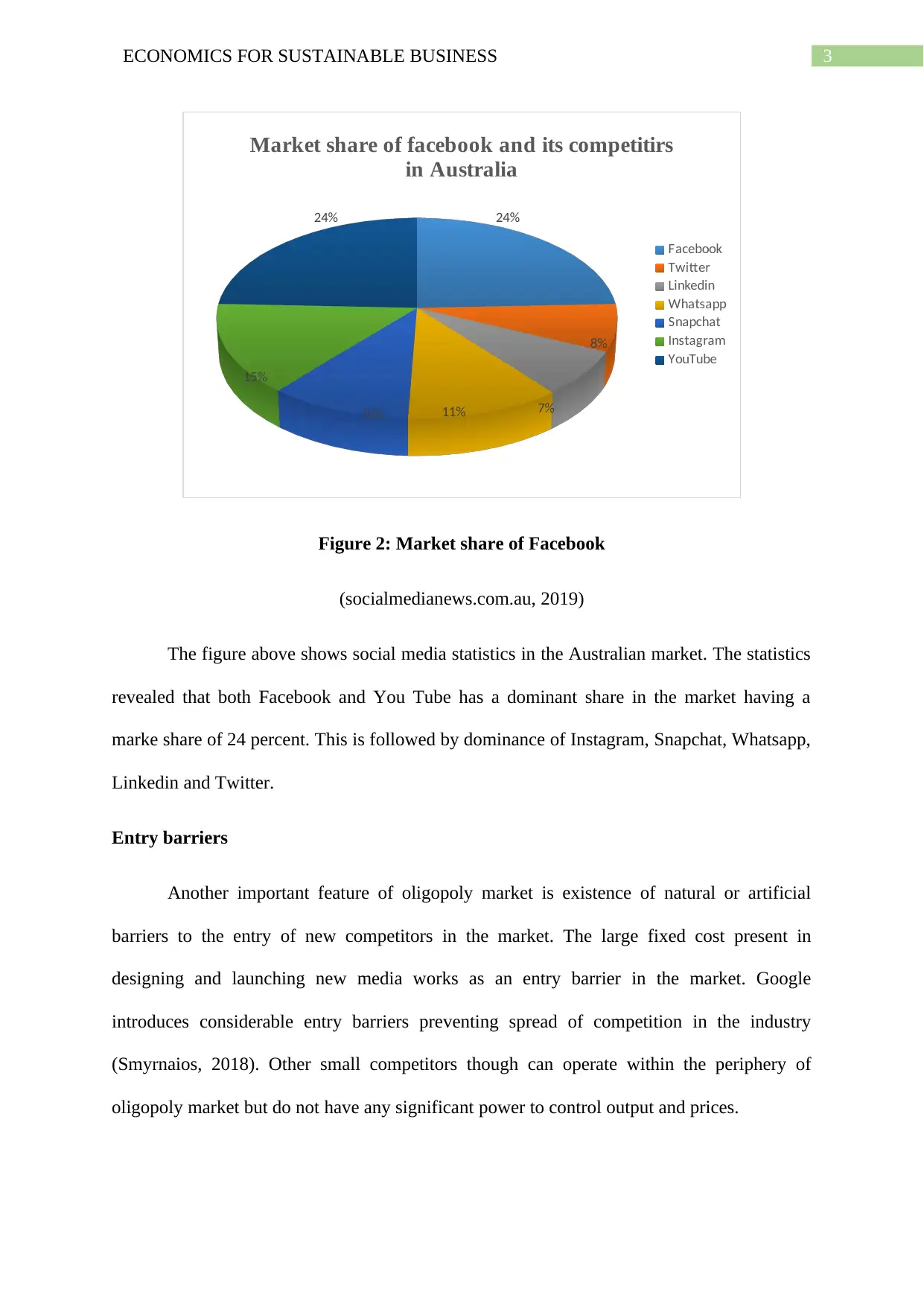
3ECONOMICS FOR SUSTAINABLE BUSINESS
24%
8%
7%11%10%
15%
24%
Market share of facebook and its competitirs
in Australia
Facebook
Twitter
Linkedin
Whatsapp
Snapchat
Instagram
YouTube
Figure 2: Market share of Facebook
(socialmedianews.com.au, 2019)
The figure above shows social media statistics in the Australian market. The statistics
revealed that both Facebook and You Tube has a dominant share in the market having a
marke share of 24 percent. This is followed by dominance of Instagram, Snapchat, Whatsapp,
Linkedin and Twitter.
Entry barriers
Another important feature of oligopoly market is existence of natural or artificial
barriers to the entry of new competitors in the market. The large fixed cost present in
designing and launching new media works as an entry barrier in the market. Google
introduces considerable entry barriers preventing spread of competition in the industry
(Smyrnaios, 2018). Other small competitors though can operate within the periphery of
oligopoly market but do not have any significant power to control output and prices.
24%
8%
7%11%10%
15%
24%
Market share of facebook and its competitirs
in Australia
Snapchat
YouTube
Figure 2: Market share of Facebook
(socialmedianews.com.au, 2019)
The figure above shows social media statistics in the Australian market. The statistics
revealed that both Facebook and You Tube has a dominant share in the market having a
marke share of 24 percent. This is followed by dominance of Instagram, Snapchat, Whatsapp,
Linkedin and Twitter.
Entry barriers
Another important feature of oligopoly market is existence of natural or artificial
barriers to the entry of new competitors in the market. The large fixed cost present in
designing and launching new media works as an entry barrier in the market. Google
introduces considerable entry barriers preventing spread of competition in the industry
(Smyrnaios, 2018). Other small competitors though can operate within the periphery of
oligopoly market but do not have any significant power to control output and prices.
Paraphrase This Document
Need a fresh take? Get an instant paraphrase of this document with our AI Paraphraser
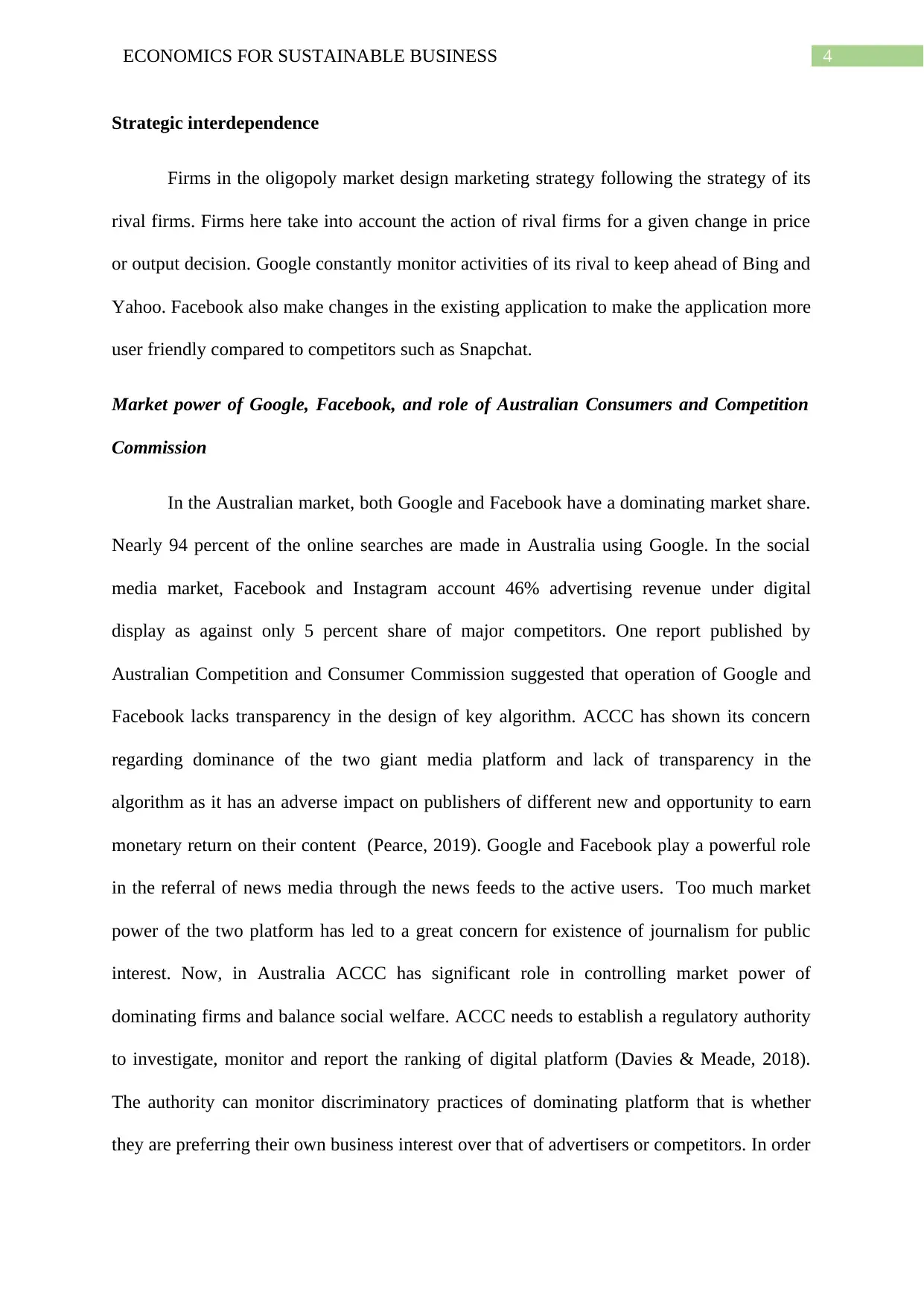
4ECONOMICS FOR SUSTAINABLE BUSINESS
Strategic interdependence
Firms in the oligopoly market design marketing strategy following the strategy of its
rival firms. Firms here take into account the action of rival firms for a given change in price
or output decision. Google constantly monitor activities of its rival to keep ahead of Bing and
Yahoo. Facebook also make changes in the existing application to make the application more
user friendly compared to competitors such as Snapchat.
Market power of Google, Facebook, and role of Australian Consumers and Competition
Commission
In the Australian market, both Google and Facebook have a dominating market share.
Nearly 94 percent of the online searches are made in Australia using Google. In the social
media market, Facebook and Instagram account 46% advertising revenue under digital
display as against only 5 percent share of major competitors. One report published by
Australian Competition and Consumer Commission suggested that operation of Google and
Facebook lacks transparency in the design of key algorithm. ACCC has shown its concern
regarding dominance of the two giant media platform and lack of transparency in the
algorithm as it has an adverse impact on publishers of different new and opportunity to earn
monetary return on their content (Pearce, 2019). Google and Facebook play a powerful role
in the referral of news media through the news feeds to the active users. Too much market
power of the two platform has led to a great concern for existence of journalism for public
interest. Now, in Australia ACCC has significant role in controlling market power of
dominating firms and balance social welfare. ACCC needs to establish a regulatory authority
to investigate, monitor and report the ranking of digital platform (Davies & Meade, 2018).
The authority can monitor discriminatory practices of dominating platform that is whether
they are preferring their own business interest over that of advertisers or competitors. In order
Strategic interdependence
Firms in the oligopoly market design marketing strategy following the strategy of its
rival firms. Firms here take into account the action of rival firms for a given change in price
or output decision. Google constantly monitor activities of its rival to keep ahead of Bing and
Yahoo. Facebook also make changes in the existing application to make the application more
user friendly compared to competitors such as Snapchat.
Market power of Google, Facebook, and role of Australian Consumers and Competition
Commission
In the Australian market, both Google and Facebook have a dominating market share.
Nearly 94 percent of the online searches are made in Australia using Google. In the social
media market, Facebook and Instagram account 46% advertising revenue under digital
display as against only 5 percent share of major competitors. One report published by
Australian Competition and Consumer Commission suggested that operation of Google and
Facebook lacks transparency in the design of key algorithm. ACCC has shown its concern
regarding dominance of the two giant media platform and lack of transparency in the
algorithm as it has an adverse impact on publishers of different new and opportunity to earn
monetary return on their content (Pearce, 2019). Google and Facebook play a powerful role
in the referral of news media through the news feeds to the active users. Too much market
power of the two platform has led to a great concern for existence of journalism for public
interest. Now, in Australia ACCC has significant role in controlling market power of
dominating firms and balance social welfare. ACCC needs to establish a regulatory authority
to investigate, monitor and report the ranking of digital platform (Davies & Meade, 2018).
The authority can monitor discriminatory practices of dominating platform that is whether
they are preferring their own business interest over that of advertisers or competitors. In order
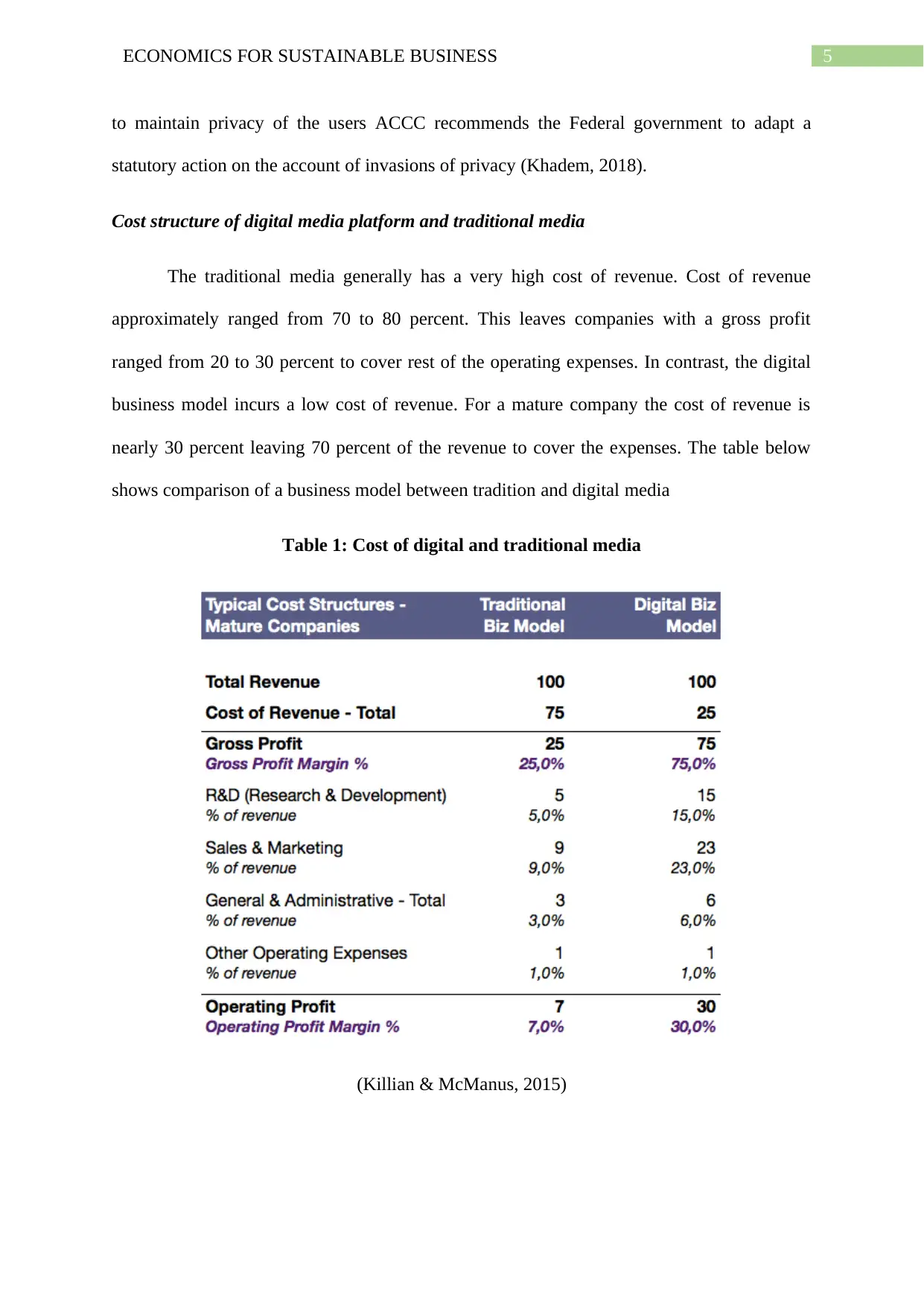
5ECONOMICS FOR SUSTAINABLE BUSINESS
to maintain privacy of the users ACCC recommends the Federal government to adapt a
statutory action on the account of invasions of privacy (Khadem, 2018).
Cost structure of digital media platform and traditional media
The traditional media generally has a very high cost of revenue. Cost of revenue
approximately ranged from 70 to 80 percent. This leaves companies with a gross profit
ranged from 20 to 30 percent to cover rest of the operating expenses. In contrast, the digital
business model incurs a low cost of revenue. For a mature company the cost of revenue is
nearly 30 percent leaving 70 percent of the revenue to cover the expenses. The table below
shows comparison of a business model between tradition and digital media
Table 1: Cost of digital and traditional media
(Killian & McManus, 2015)
to maintain privacy of the users ACCC recommends the Federal government to adapt a
statutory action on the account of invasions of privacy (Khadem, 2018).
Cost structure of digital media platform and traditional media
The traditional media generally has a very high cost of revenue. Cost of revenue
approximately ranged from 70 to 80 percent. This leaves companies with a gross profit
ranged from 20 to 30 percent to cover rest of the operating expenses. In contrast, the digital
business model incurs a low cost of revenue. For a mature company the cost of revenue is
nearly 30 percent leaving 70 percent of the revenue to cover the expenses. The table below
shows comparison of a business model between tradition and digital media
Table 1: Cost of digital and traditional media
(Killian & McManus, 2015)
⊘ This is a preview!⊘
Do you want full access?
Subscribe today to unlock all pages.

Trusted by 1+ million students worldwide
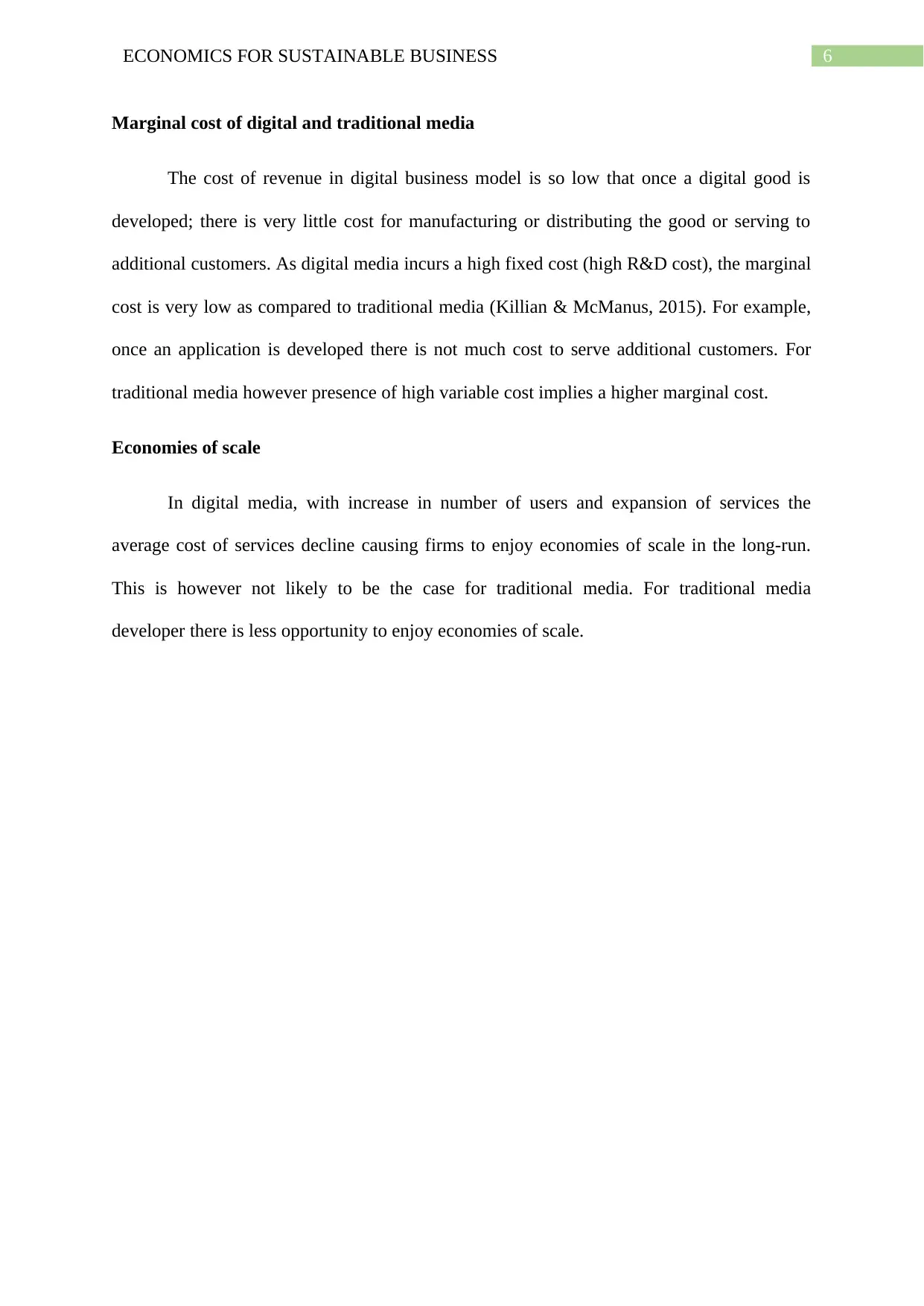
6ECONOMICS FOR SUSTAINABLE BUSINESS
Marginal cost of digital and traditional media
The cost of revenue in digital business model is so low that once a digital good is
developed; there is very little cost for manufacturing or distributing the good or serving to
additional customers. As digital media incurs a high fixed cost (high R&D cost), the marginal
cost is very low as compared to traditional media (Killian & McManus, 2015). For example,
once an application is developed there is not much cost to serve additional customers. For
traditional media however presence of high variable cost implies a higher marginal cost.
Economies of scale
In digital media, with increase in number of users and expansion of services the
average cost of services decline causing firms to enjoy economies of scale in the long-run.
This is however not likely to be the case for traditional media. For traditional media
developer there is less opportunity to enjoy economies of scale.
Marginal cost of digital and traditional media
The cost of revenue in digital business model is so low that once a digital good is
developed; there is very little cost for manufacturing or distributing the good or serving to
additional customers. As digital media incurs a high fixed cost (high R&D cost), the marginal
cost is very low as compared to traditional media (Killian & McManus, 2015). For example,
once an application is developed there is not much cost to serve additional customers. For
traditional media however presence of high variable cost implies a higher marginal cost.
Economies of scale
In digital media, with increase in number of users and expansion of services the
average cost of services decline causing firms to enjoy economies of scale in the long-run.
This is however not likely to be the case for traditional media. For traditional media
developer there is less opportunity to enjoy economies of scale.
Paraphrase This Document
Need a fresh take? Get an instant paraphrase of this document with our AI Paraphraser
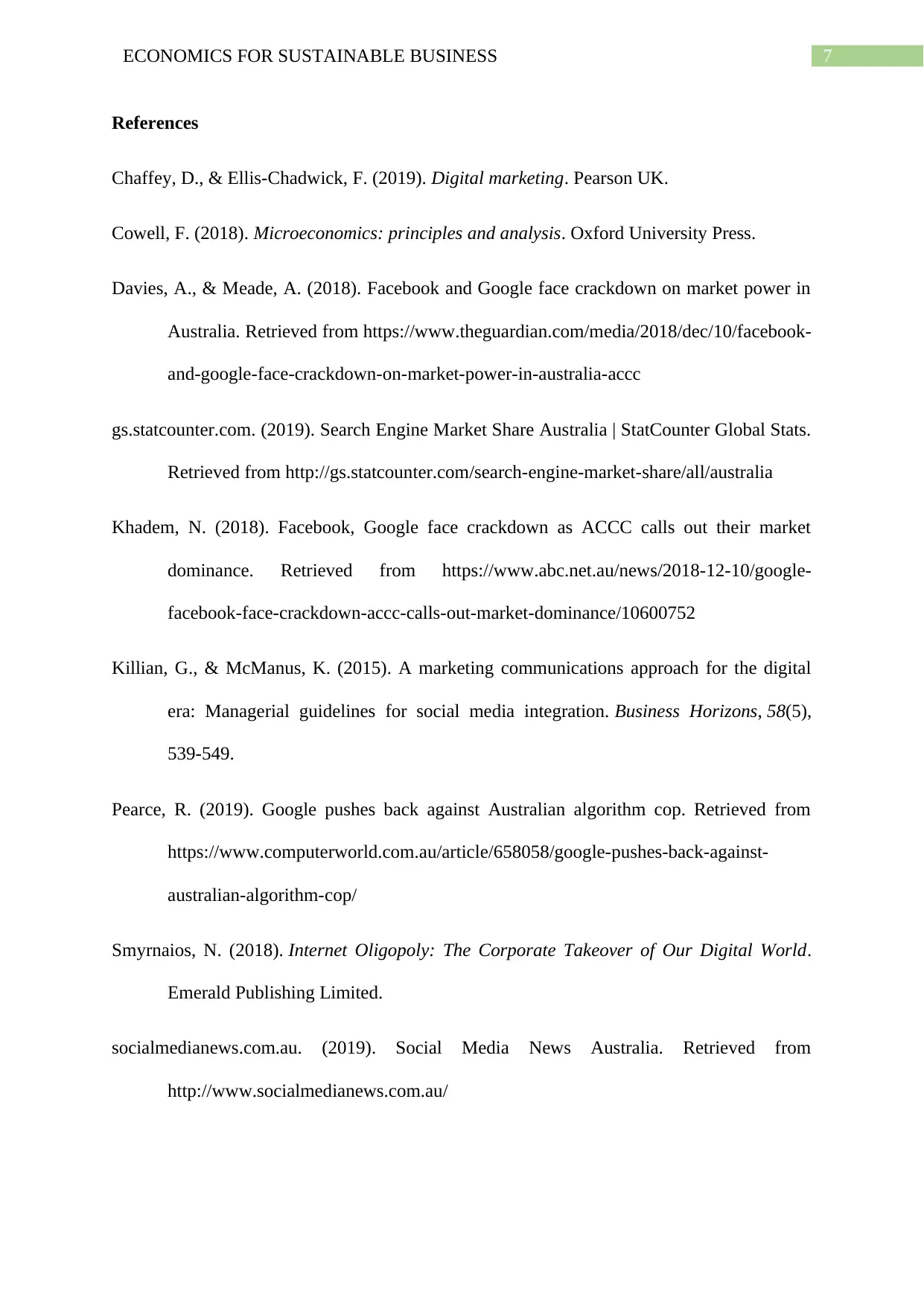
7ECONOMICS FOR SUSTAINABLE BUSINESS
References
Chaffey, D., & Ellis-Chadwick, F. (2019). Digital marketing. Pearson UK.
Cowell, F. (2018). Microeconomics: principles and analysis. Oxford University Press.
Davies, A., & Meade, A. (2018). Facebook and Google face crackdown on market power in
Australia. Retrieved from https://www.theguardian.com/media/2018/dec/10/facebook-
and-google-face-crackdown-on-market-power-in-australia-accc
gs.statcounter.com. (2019). Search Engine Market Share Australia | StatCounter Global Stats.
Retrieved from http://gs.statcounter.com/search-engine-market-share/all/australia
Khadem, N. (2018). Facebook, Google face crackdown as ACCC calls out their market
dominance. Retrieved from https://www.abc.net.au/news/2018-12-10/google-
facebook-face-crackdown-accc-calls-out-market-dominance/10600752
Killian, G., & McManus, K. (2015). A marketing communications approach for the digital
era: Managerial guidelines for social media integration. Business Horizons, 58(5),
539-549.
Pearce, R. (2019). Google pushes back against Australian algorithm cop. Retrieved from
https://www.computerworld.com.au/article/658058/google-pushes-back-against-
australian-algorithm-cop/
Smyrnaios, N. (2018). Internet Oligopoly: The Corporate Takeover of Our Digital World.
Emerald Publishing Limited.
socialmedianews.com.au. (2019). Social Media News Australia. Retrieved from
http://www.socialmedianews.com.au/
References
Chaffey, D., & Ellis-Chadwick, F. (2019). Digital marketing. Pearson UK.
Cowell, F. (2018). Microeconomics: principles and analysis. Oxford University Press.
Davies, A., & Meade, A. (2018). Facebook and Google face crackdown on market power in
Australia. Retrieved from https://www.theguardian.com/media/2018/dec/10/facebook-
and-google-face-crackdown-on-market-power-in-australia-accc
gs.statcounter.com. (2019). Search Engine Market Share Australia | StatCounter Global Stats.
Retrieved from http://gs.statcounter.com/search-engine-market-share/all/australia
Khadem, N. (2018). Facebook, Google face crackdown as ACCC calls out their market
dominance. Retrieved from https://www.abc.net.au/news/2018-12-10/google-
facebook-face-crackdown-accc-calls-out-market-dominance/10600752
Killian, G., & McManus, K. (2015). A marketing communications approach for the digital
era: Managerial guidelines for social media integration. Business Horizons, 58(5),
539-549.
Pearce, R. (2019). Google pushes back against Australian algorithm cop. Retrieved from
https://www.computerworld.com.au/article/658058/google-pushes-back-against-
australian-algorithm-cop/
Smyrnaios, N. (2018). Internet Oligopoly: The Corporate Takeover of Our Digital World.
Emerald Publishing Limited.
socialmedianews.com.au. (2019). Social Media News Australia. Retrieved from
http://www.socialmedianews.com.au/
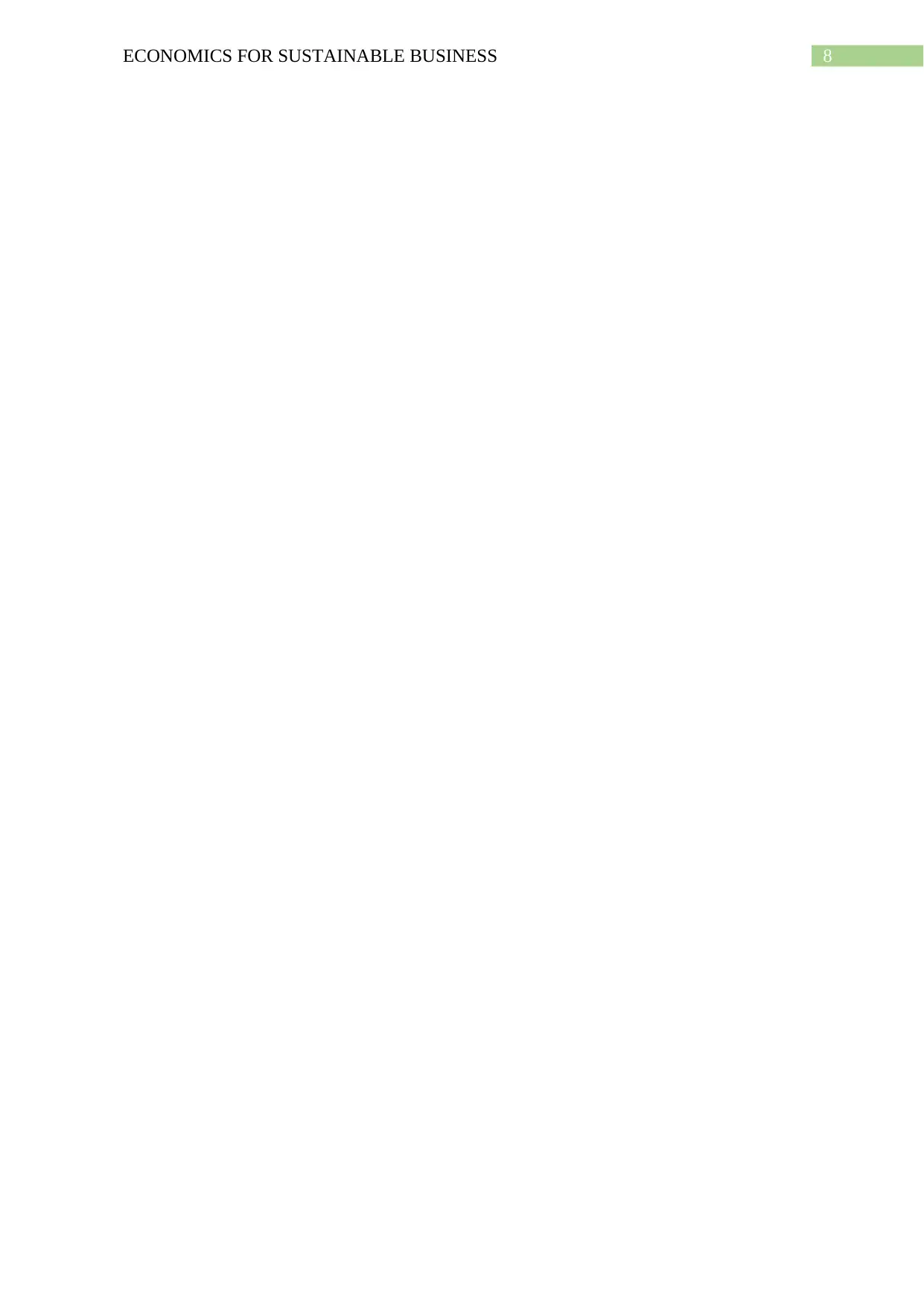
8ECONOMICS FOR SUSTAINABLE BUSINESS
⊘ This is a preview!⊘
Do you want full access?
Subscribe today to unlock all pages.

Trusted by 1+ million students worldwide
1 out of 9
Your All-in-One AI-Powered Toolkit for Academic Success.
+13062052269
info@desklib.com
Available 24*7 on WhatsApp / Email
![[object Object]](/_next/static/media/star-bottom.7253800d.svg)
Unlock your academic potential
Copyright © 2020–2025 A2Z Services. All Rights Reserved. Developed and managed by ZUCOL.

